Lots of what your pet birds do will be self-explanatory – things like feeding, flying, bickering, bathing, and climbing. But there are other types of movement and body language that require a little homework on your part if you are to fully understand what your parrot is ‘saying’ with his body.
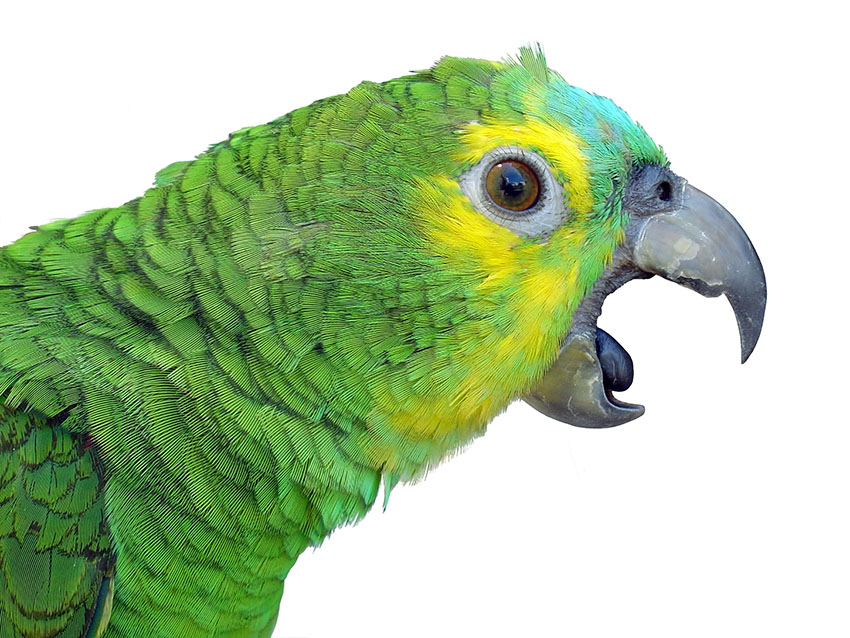
Blue-Fronted Amazon - expressive beak
Beaks
- Grinding and Clicking – see the Parrot Sounds section.
- Jousting – birds that grab each other's beaks in a kind of wrestling match are simply playing. If real anger is involved, there will be a lot more flapping and squawking.
- Wiping – Parrots, like most birds, wipe their beaks after eating, especially if the food is wet or slightly messy (banana, for example). Some parrots wipe wet beaks as a means of marking territory.
Biting
This is always an unwelcome behaviour, and is a sign of aggression, over-defensiveness or fear. You can see most bites coming – the bird will crouch and open his beak prior to the lunge. Getting the parrot used to your presence will help to defuse the behaviour. If it’s taking place in an aviary, you may have an overcrowding problem. If all else fails, a biter will have to be isolated from the other birds until he shows signs of calming down.
Chewing
Parrots chew as busily and contentedly as mice. It’s important to indulge this natural instinct with chewing toys made from appropriate (i.e. non-toxic) materials such as wood or egg boxes.
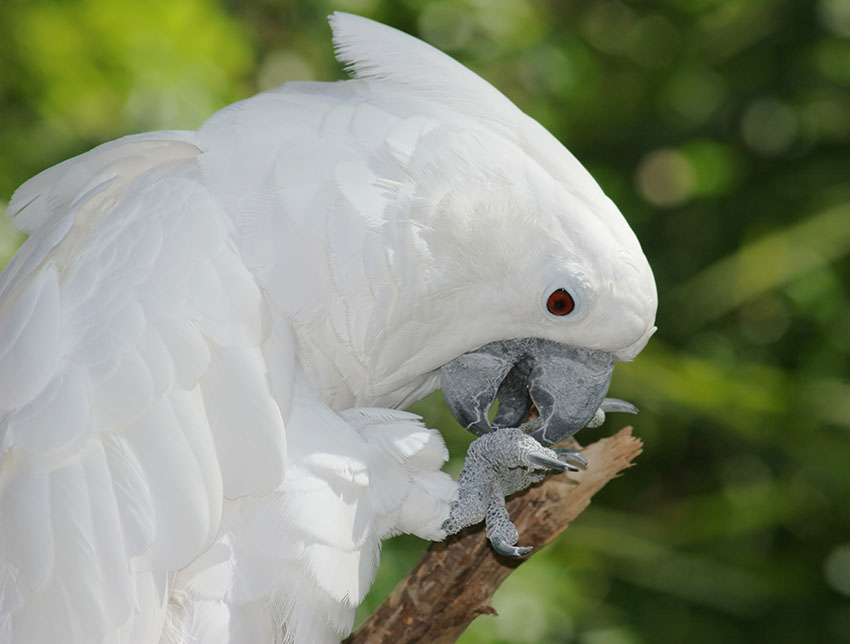
White Cockatoo - this family of parrots all sport crests
Crests
Cockatiels and Cockatoos use their crests to express themselves. When relaxed and happy, the bird will have its crest flat or ever-so-slightly raised. If the bird is crouching and hissing, however, this means he is angry and afraid. A raised crest indicates excitement. This is usually a sign that the parrot is pleased to see you (or the food you are carrying!). This is not to be confused with a crest that’s fully-raised and stays in that position. This is a sign of fear, anger or some other over-stimulated state of mind. Beware the angry peck!
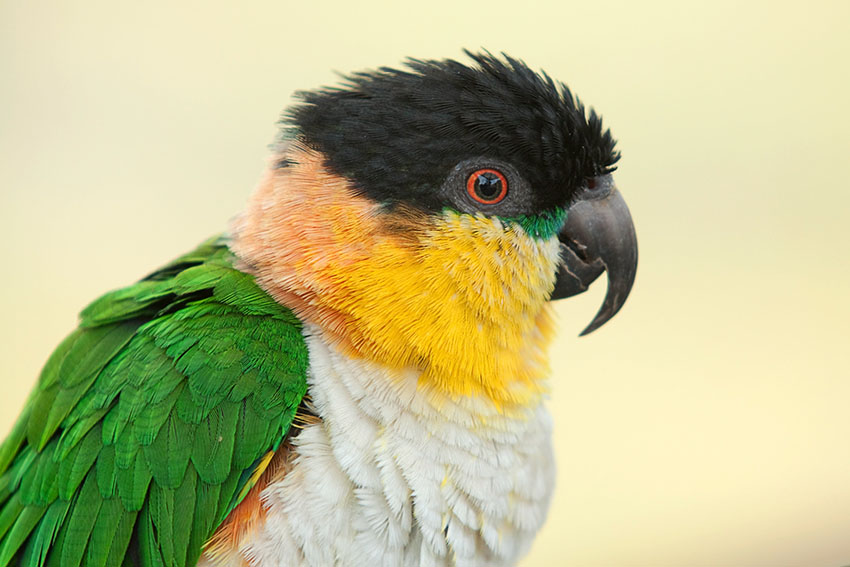
Black-Headed Caique, ruffling feathers
Feathers, Ruffled
This is part of the preening or grooming process. It shakes off the dust and gives the parrots’ beaks or toes access to the roots of the feathers where the dirt accumulates. It also acts like the shaking of a quilt, allowing the feathers to settle back neatly into their correct positions. A quick shivering ruffle is sometimes performed to relieve tension after a spell of bickering or chasing. Constantly fluffed-up feathers may mean the parrot is too cold, or ill. Any doubts about the bird’s health should be addressed by taking a trip to the vet.
Hanging Upside Down
This is a sign of a happy bird. Not all parrots do it, but many seem to enjoy the sensation, and it’s nothing to worry about.
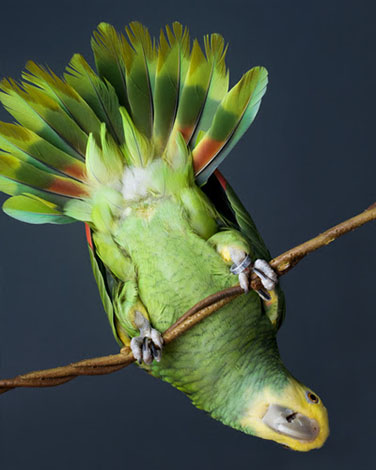
Double Yellow-Headed Amazon showing off
Heads
- Bobbing – Parrots bob for attention, or as part of their courtship ritual. Single birds will often adopt head-bobbing habits.
- Shaking – This seems to be a habit with no obvious purpose, and is particularly common in African Greys. It’s nothing to worry about, but make sure your bird is not bored – replace toys or spend more time with him.
Legs and Feet
- Raised – a raised leg with a ‘clenched’ claw is simply a way or resting. In the cold birds do this to preserve warmth, but some just like lounging around on one leg. Many species like to perch on one foot while feeding with the other.
- Tapping – this is a Cockatoo thing, although other species sometimes get into the habit too. A foot tapping on a perch tends to mean “This is my territory”.
- Collapsing – This is when a bird you are handling squats down, as if he’s gone weak at the knees. It usually means he’s spotted that you’re about to return him to the cage, and he doesn’t want to go back in just yet. Many birds learn that ‘collapsing’ in this way brings extra minutes of attention, and make it a habit. If you return the parrot to its cage or perch, the legs will magically work again!
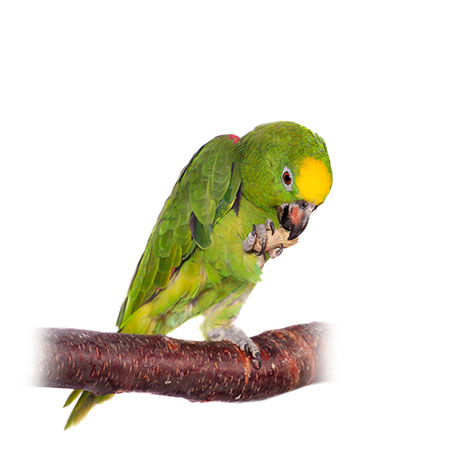
Yellow-Crowned Amazon - parrot's feet can be thought of as hands
Regurgitating
The saying “sick as a parrot” stems from the birds’ eagerness for regurgitation (i.e. ejecting pre-swallowed food via the beak). Parrots feed their young in this way, and the male feeds his nesting partner similarly as part of the bonding process. If your pet does this to you, with dilated pupils (eye-pinning), head-bobbing and neck-stretching, it is a sign of affection, but not one you will be keen to encourage. Make no fuss, and don’t speak to the bird when it behaves this way. It will soon get the message that this particular type of affection doesn’t work with human friends.
Scratching
Scratching the head and neck area is just part of the preening process, tackling those places the beak can’t reach. If the parrot scratches with its claws on the cage bottom, it is foraging, chicken-like. Not all species do this, but it’s a common pastime for the African Greys.
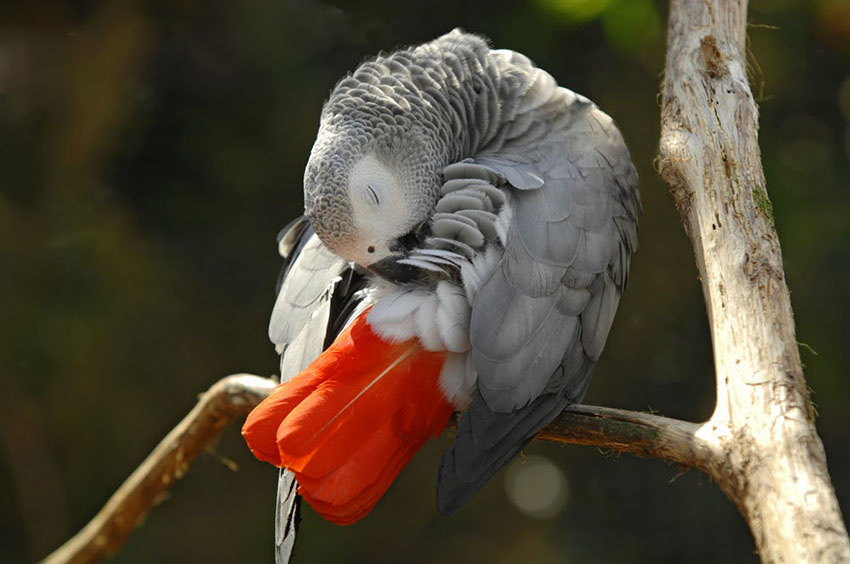
The African Grey is one of the few parrots to scratch the ground for food
Tail
- Wagging (side to side) – this means one of two things: the parrot is happy to see you (or who/whatever else the tail is being wagged at); or he is about to poo. It’s a sign to look out for if you are attempting to house-train your pet (see the Toilet Training a Parrot section of this guide).
- Flipping (jerking up and down) – this is another sign of happiness: the parrot is pleased to see you, or is enjoying a game, or a favourite food.
- Bobbing – a tail that ‘beats’ gently up and down and accompanied by panting means the parrot is catching his breath after strenuous exercise. If no exercise has taken place, it’s a sign of illness and you need to call the vet.
- Fanning – this is generally a display of anger or aggression. The behaviour stems from shows of dominance in the wild, often to do with territory or breeding.
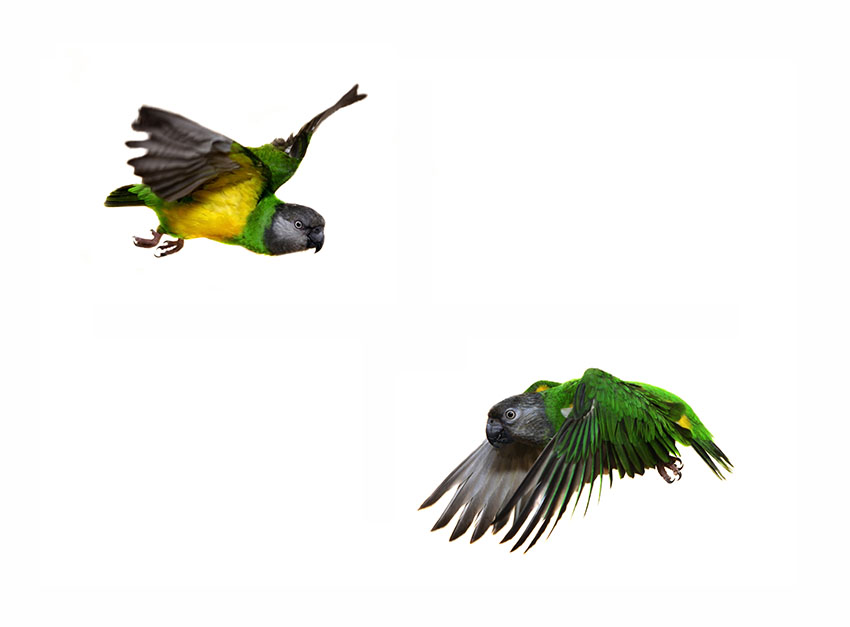
Senegal Parrots in flight
Wings
- Drooping – Unless your parrot is very young, wing drooping indicates exhaustion, overheating or illness. If the bird has just bathed, drooping wings simply mean he is drying himself.
- Flapping – Parrots use their wings to communicate. Flapping them, without attempting to fly, means one of three things. It might just be a spot of morning or post-nap exercise; your parrot may be trying to get your attention; or he may simply be in a state of great happiness.
- Lifting – This is often used to cool down, or may simply be a gentle stretch.
- Ruffling – After flight, a bird ruffles its wings to shake and readjust them into the correct position. But the wings may also be ruffled if the parrot is agitated or in pain. If your pet hunches his shoulders at the same time and bobs his head, he is desperate for your attention (often because his food or water bowl is empty). Birds in the mating season perform this hunched, head-bobbing, wing-shaking dance too.
Clipping Parrot Wings
Wing-clipping is not compulsory, but many parrot keepers recommend it. The purpose is not to prevent flight, but to slow it down. If correctly clipped, the parrot will be able to fly, but will not have much ‘lift’. In confrontational situations, this will (for example) prevent an angry male from pursuing and injuring an unwilling female. It also makes recapturing escaped birds a little easier.
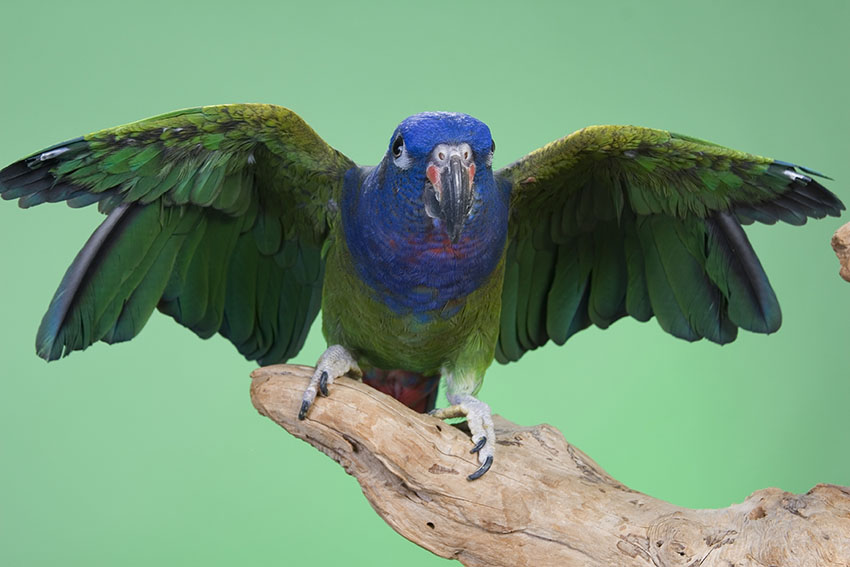
This Blue-Headed Parrot has had its primary wing feathers clipped
The clipping must be performed properly, by someone who knows what they’re doing. Poorly clipped wings can make the parrot lose its balance, or may cause bleeding or injury. A badly clipped feather may also become a source of irritation to the bird, resulting in self-pecking and plucking.
Wings should never be clipped before the parrot has learned how to fly, otherwise the bird will not master the balance required for takeoff and landing.
Comments
Ronald, 3 March 2024
Stopping my African Grey's habit of pecking on the bottom of the cage?
Ronald, 3 March 2024
I have a 15yr. old African Grey who's getting a habit of pecking on the bottom of its cage and won't stop until I open the door and run him up to the perches. What suggestions do you have to correct this habit?
Bob, 25 February 2024
My conure is clinging to his for two weeks What’s wrong?
Frank, 11 December 2023
My blue gold macaw who is 21 years old will not stop feeding his toys and becomes very aggressive if I try to remove them. Also, he does not relieve himself in the cage. He holds it in all night until I put him on his perch in the morning. Should I be concerned?
Clara, 6 January 2023
My blue fronted Amazon 1 year and 7 months old parrot frequently goes thru the motions of swallowing with his mouth open. Can this mean he is having swallowing issues, he usually does it after he eats his dry food.